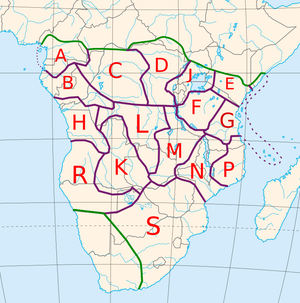Guthrie classification of Bantu languages
| Bantu | |
|---|---|
| Narrow Bantu | |
| Geographic distribution: |
Africa, from approximately the equator south |
| Linguistic classification: | Niger–Congo |
| Subdivisions: |
|
| Glottolog: | narr1281 |

The approximate locations of the sixteen Guthrie Bantu zones, including the addition of a zone J
|
|
The 250 or so "Narrow Bantu languages" are conventionally divided up into geographic zones first proposed by Malcolm Guthrie (1967–1971). These were assigned letters A–S and divided into decades (groups A10, A20, etc.); individual languages were assigned unit numbers (A11, A12, etc.), and dialects further subdivided (A11a, A11b, etc.). This coding system has become the standard for identifying Bantu languages; it was the only practical way to distinguish many ambiguously named languages before the introduction of ISO 639-3 coding, and it continues to be widely used. Only Guthrie's Zone S is (sometimes) considered to be a genealogical group; since then a Zone J has been set up as another possible genealogical group bordering the Great Lakes.
The list is first summarized, with links to articles on accepted groups of Bantu languages (bold decade headings). Following that is the complete 1948 list, as updated by Guthrie in 1971 and by Maho in 2009.
The list below reflects Guthrie as updated by Maho (2009). Not included in detail are the Northeast Bantu languages characterized by Dahl's Law, which is thought to be a genealogical group, cuts across the Guthrie system, and is covered at Northeast Bantu. Other groups with dedicated articles, such as Southern Bantu (Zone S) are also only summarized here, so that the initial listing is only a summary and an index for other articles.
Note that Ethnologue made multiple changes to Guthrie in an attempt to make the classification more historically accurate. However, the changes are inconsistent, and Ethnologue has not been followed here, though it is publicly available online. Thus a code may mean different things depending on whether Guthrie or SIL is being followed. (See link below for the SIL code assignments.) The updates in Maho (2009), on the other hand, are designed to be compatible with the original values of the codes.
Bantu has long been divided into Northwest Bantu (Forest Bantu) and Central Bantu (Savanna Bantu) branches based upon tone patterns, but there is little agreement as to which Guthrie zones (or which parts of zones) should be in either, the dichotomy is dubious, and they have not been followed here.
...
Wikipedia
